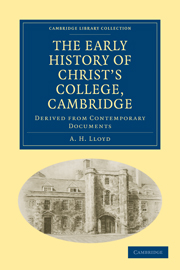Book contents
- Frontmatter
- Preface
- Contents
- LIST OF ILLUSTRATIONS
- List of Abbreviations
- Chronological Summary
- Dedication
- Chapter I William Byngham, the First Founder
- Chapter II The Dispute with John Langton
- Chapter III The First Royal Licence, 1439
- Chapter IV The Expansion of the Milne Street Site
- Chapter V The Royal Licences of 1442
- Chapter VI Marking Time: 1443 to 1446
- Chapter VII The Royal Licence of 1446 and its period
- Chapter VIII The Foundation Charter of the College of Godshouse and its period
- Chapter IX The Relationship of Godshouse and Clare Hall
- Chapter X The Last Days of William Byngham
- Chapter XI The Proctorship of John Hurte, 1451–1458, and of William Fallan, 1458–1464
- Chapter XII The Proctorship of William Basset, 1464–1477
- Chapter XIII The Proctorship of Ralph Barton, 1477–1490
- Chapter XIV The Proctorship of John Syclyng: Early Years, 1490–1496
- Chapter XV The Proctorship of John Syclyng: Later Years, 1496–1506
- Chapter XVI The Negotiations between Godshouse and the Lady Margaret
- Chapter XVII Syclyng's Death and Will
- Chapter XVIII The Buildings and Furniture remaining from the Godshouse period
- Chapter XIX Godshouse and Christ's College
- Appendix
- A
- B
- C
- D The Financial Position of the College at the Death of the Lady Margaret
- E The Council in the Marches of Wales: Documents from the Reign of Henry VII found in the College
- Index
- Plate section
E - The Council in the Marches of Wales: Documents from the Reign of Henry VII found in the College
Published online by Cambridge University Press: 05 October 2010
- Frontmatter
- Preface
- Contents
- LIST OF ILLUSTRATIONS
- List of Abbreviations
- Chronological Summary
- Dedication
- Chapter I William Byngham, the First Founder
- Chapter II The Dispute with John Langton
- Chapter III The First Royal Licence, 1439
- Chapter IV The Expansion of the Milne Street Site
- Chapter V The Royal Licences of 1442
- Chapter VI Marking Time: 1443 to 1446
- Chapter VII The Royal Licence of 1446 and its period
- Chapter VIII The Foundation Charter of the College of Godshouse and its period
- Chapter IX The Relationship of Godshouse and Clare Hall
- Chapter X The Last Days of William Byngham
- Chapter XI The Proctorship of John Hurte, 1451–1458, and of William Fallan, 1458–1464
- Chapter XII The Proctorship of William Basset, 1464–1477
- Chapter XIII The Proctorship of Ralph Barton, 1477–1490
- Chapter XIV The Proctorship of John Syclyng: Early Years, 1490–1496
- Chapter XV The Proctorship of John Syclyng: Later Years, 1496–1506
- Chapter XVI The Negotiations between Godshouse and the Lady Margaret
- Chapter XVII Syclyng's Death and Will
- Chapter XVIII The Buildings and Furniture remaining from the Godshouse period
- Chapter XIX Godshouse and Christ's College
- Appendix
- A
- B
- C
- D The Financial Position of the College at the Death of the Lady Margaret
- E The Council in the Marches of Wales: Documents from the Reign of Henry VII found in the College
- Index
- Plate section
Summary
‘The scantiness of the material for the early history of the Council in the Marches prevents any detailed description of its procedure before the reign of Henry VIII’, and where so little remains in the aggregate it seems to be a duty to present whatever additional matter may come to light.
The prince's council had existed ever since the time of the first Prince of Wales but our knowledge of its history before the reign of the first Tudor monarch is singularly slight. Its primary function was concerned with the administration of the prince's estates, but such duties, in a disturbed area controlled by an unwelcome, alien authority, must have involved the exercise of judicial functions in very large measure. The prince's council had jurisdiction ordinarily within the principality alone, but that limitation should not be taken too literally. The area of the principality had extension eastward in the middle ages beyond that which it possesses in modern times, and it was liable to important fluctuations due to expansion and contraction following alternating failure and success of the Welsh in revolt under popular leadership, of which ample illustration may be found in the volumes of Rotuli Parliamentorum and The Statutes of the Realm. Thus, the estates where the college suffered the injury and damage which gave rise to the complaints expressed in these documents, though lying then partly within the borders of Herefordshire, are constantly described in royal letters patent of Henry VI as lying in Wallia or in North Wallia.
- Type
- Chapter
- Information
- The Early History of Christ’s College, CambridgeDerived from Contemporary Documents, pp. 436 - 446Publisher: Cambridge University PressPrint publication year: 2010First published in: 1934



